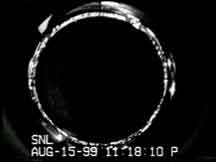Late on the night of Sunday, Aug. 15, the Albuquerque sky lit up just for an instant as bright as day. Eyewitnesses and there were thousands who were out and about at 11:18 p.m. that night didn’t know quite what to make of the event, but everyone who saw it knew they’d witnessed something extraordinary.

That’s different now, thanks to Sandia’s unique all-sky camera system, designed precisely in order to capture transient sky phenomena on videotape. The all-sky program is funded by Sandia’s Laboratory Directed Research and Development program and involves Depts. 9201 and 5901. An analysis of the video made that night establishes definitively that the flash was caused by a meteor.
The images here are frames from a videotape made by the all-sky camera atop Bldg. 890 in Sandia’s Tech Area 1. The camera views a spherical convex mirror that looks like a chrome hub-cap, which produces a fish-eye image of the entire sky. The horizon is ringed by city lights. In the images, north is toward the upper left. The meteor appears to the west, in the lower left quadrant, and descends into the clouds as it lights up the entire sky. A radiometer indicates that the apparent magnitude peaked at about 16.5, which is about 30 times as bright as the full moon. Directly beneath the fireball it may have been 300 times as bright as the moon. Research has shown that meteoroids weighing roughly one ton get this bright when they enter the atmosphere.
The entire sequence of images here represents a timespan of perhaps two seconds.
A story about Sandia’s all-sky project will be featured in an upcoming issue of the Lab News.